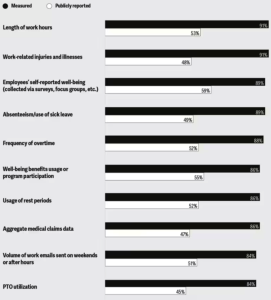As trends go, the one that requires organizations to publish more and more HR-related metrics has – despite some pushback initially – been a positive one.
Whether its companies releasing data about their ethnic make-up; their gender pay-gap disparities, C-suite representation, and just recently, starting salaries on job ads, it’s hard to argue against this data beginning to have positive impacts on diversity and equality.
For even though headline numbers can sometimes paint a starker picture than reality – often hiding more complex nuances within it – transparency does tend to breed action.
In 2020, for example, Facebook made a pledge to double it intake of black and Latinx employees by the end of this year. Twitter meanwhile, promised it would increase the share of underrepresented employees to 25% of the US workforce by 2025. While they may not achieve these pledges, at least the intent is there, and there for all to see.
Wellbeing as a metric
But there’s one metric that has been rising inexorably in importance over the last few years, but which is also the one that has so-far avoided being required to report on – and that’s employee wellbeing.
So should companies be required to publish data on this? And what’s the actual appetite for it?
Well, the debate around wellbeing reporting is once more on the agenda, following the publication last week of Workplace Intelligence/Deloitte’s second Annual Workplace Wellbeing Study.
Amongst the numerous (and occasionally worrying) statistics – like the fact most staff say their well-being either worsened or stayed the same last year, and only around one-third say their health improved – is one that that caught our eye.
This is the finding that 85% of the C-suite say companies should be required to publicly report their workforce well-being metrics.
Has wellbeing reporting finally got widespread backing?
Considering there is still significant reluctance by many firms to go public on some of the easier disparities they could report on (last year Just Capital found only 43% of America’s largest 100 employers disclosed their race/ethnicity pay equity analysis), the fact so many would want to publicize their wellbeing metrics seems surprising.
It’s surprising on a number of levels.
Firstly, ‘wellbeing’ is a term that has multiple interpretations and multiple factors that can impact it (including those that are definitely non-work related).
Secondly, it’s surprising because the same research also says only 50% currently do, and it’s not always very joined up at that. Metrics that do get published tend to be things like uptake of certain benefits; uptake of flexibility; working hours data and self-reported wellbeing surveys – which don’t quite give the full picture.
So what’s going on?
TLNT decided to exclusively speak to Dan Schwabel, managing partner at Workplace Intelligence to find out…
Q: Support from the C-suite to publish wellbeing data might come as a big surprise to many, so what do you put this down to?
A: “I think there’s a few factors at play here – factors that are starting to come together. This is our second year of the study, and the research finds wellbeing issues are starting to become a uniting one, across all job levels. Our data found that 60% of employees said they would seriously consider quitting their job for one that better supported their wellbeing, but this was even higher amongst managers (64%) and those in the C-suite (75%). So, it seems those at the top of organizations are suffering too – the very people who are most in a position to do something about it. Wellbeing does just seem to be a universal topic people are talking about – especially post-pandemic. It’s also the issue prospective employees want to rate businesses on, and so it’s attraction and retention issue like never before.”
Q: But isn’t the problem with wellbeing that it’s just so difficult to define, and plus it’s also massively impacted by things outside of the workplace?
A: “Yes, I think you’re right. One of the big findings of the research is that what one leader defines as them making a wellbeing statement/commitment, others may think it’s not. Some 84% of the C-suite we surveyed said their company has made public wellbeing commitments, but just 39% of employees agreed with this – suggesting there is a big disparity. Differences in perception are seen throughout the report: for instance, most employees thought their health had worsened over the last year; but most leaders (three-quarters) thought it had improved. So there are big differences in people’s perception of reality.”
Q: While leaders might say they want to report wellbeing, isn’t it also the case they’re afraid of it too – so their intent might not actually be backed up?
A: “Yes, this is certainly a factor. We found that around 34% of leaders said they are waiting for government to set up some sort of wellbeing reporting framework, so that when they do reporting, it’s the same for all companies. We also picked up fears of reputational damage. Some 23% said they would be afraid of the employer-brand impact that publishing their data could give them – which I think also feeds into wanting more concrete frameworks that are the same for everyone.”
Q: Isn’t it just the case that you need one company to start the ball rolling, and others will be forced into following them?
A: “A telling finding was that 30% thought reporting on certain wellbeing metrics would seem ‘trivial’ to some, so I think there is real wellbeing reporting hesitancy. Some certainly see reporting on wellbeing as a gamble, but this is where I think inter-company peer-pressure can certainly play a role. When companies begin to realize, that ‘not’ publishing wellbeing will impact them competitively, and reduce their pool of talent, I think that they’ll begin to take it more seriously. Amongst managers, 70% say rigid internal processes and having an unsupportive workplace culture prevent them from doing more to support their teams’ wellbeing, so this needs to be looked at too.”
Q: Is there much movement around what sorts of things wellbeing needs to report on?
A: “It’s definitely the case that ‘wellbeing’ as a concept can be hard to pin-down, and that there’s demand for something more standard that can be applied across the board. But there are moves beginning to happen in this space around developing such metrics. Axa, Prudential and Aon have recently [last October] come together to fund a new ‘Mental Health at Work Index’. This will rate and advise on company’s wellness programmes. It aims to define what ‘good’ looks like, so this is a promising start.”
Q: So, on balance, how ‘up for it’ do you think companies really are on reporting wellbeing?
A: “Our statistics suggest they are. Some 85% of the C-suite say they’ll become more responsible for workforce wellbeing over the next few years. Employees are demanding it too – we found that 78% of employees feel their company’s leaders should step down if they can’t maintain an acceptable level of workforce wellbeing, while 72% believe executives’ bonuses should be tied to workforce wellbeing metrics. This is all very likely to keep the wellbeing agenda high. If the labor market gets even tighter, then the pressure to make wellbeing a point of difference will also increase, so there are positive signs ahead.”
What the research also found:
- Only around one-in-three employees feel their job has a positive impact on their physical (33%), mental (32%), and social (31%) wellbeing
- High numbers of employees say their job negatively affects their physical (33%), mental (40%), and social (21%) wellbeing.
- Nearly all employees (94%) feel their manager should have at least some responsibility for their wellbeing…
- …BUT nearly a third of employees (32%) don’t feel their manager cares about their wellbeing
- 77% say their company has joined a coalition/community (59%) or signed a pledge (39%) related to workforce wellbeing.
Barriers to measuring wellbeing:
According to Workplace Intelligence and Deloitte barriers still exist:
- 21% say they don’t have the right team members to monitor commitments
- 20% report that they don’t see other organizations doing this
- 19% don’t have buy-in from all of their leaders or managers
What do companies currently measure/report?
According to Workplace Intelligence and Deloitte, the following wellbeing metrics were currently found to be measured/reported on:

